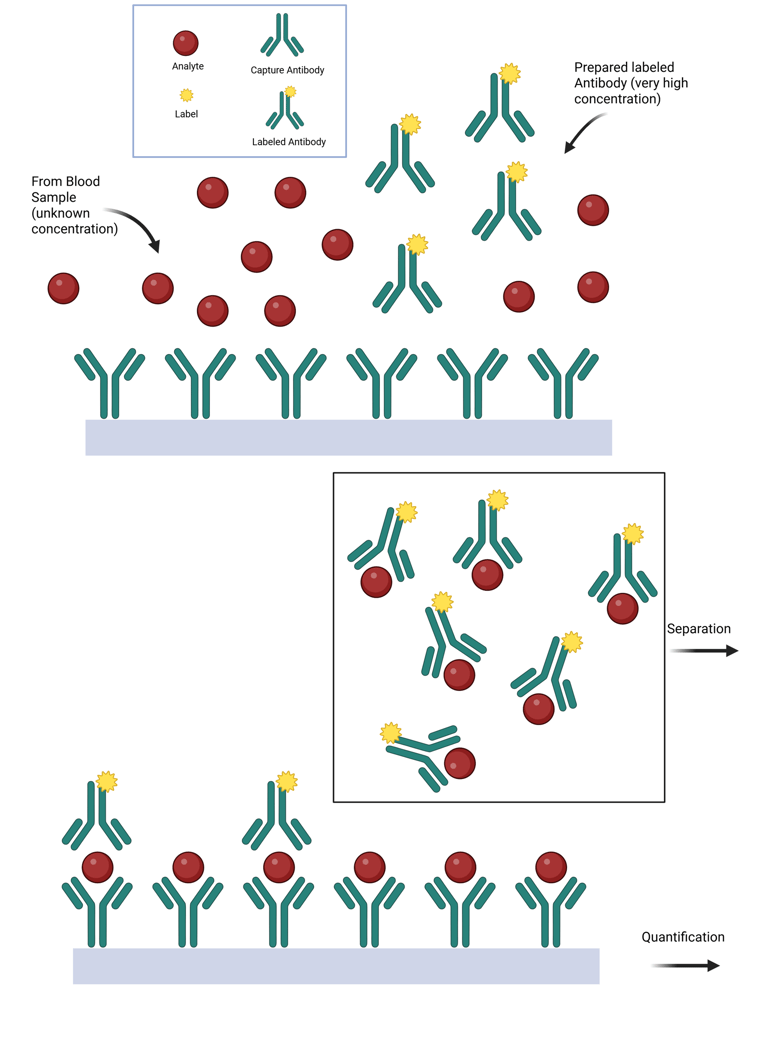The Hook Effect
The hook effect is a phenomenon in immunometric assays where extremely high concentrations of an analyte paradoxically result in falsely low measured values.
When antigen concentrations approach the binding capacity of the capture antibody, the assay signal plateaus, and no longer rises proportionally with antigen levels. Beyond this threshold, laboratories typically dilute the specimen to remain within the measurable range.
However, when the antigen concentration greatly exceeds the capture antibody’s capacity, excess antigen can saturate both the capture and detection antibodies, preventing the formation of the antibody–antigen–antibody "sandwich" complex and causing a paradoxical decrease in signal. In extreme cases, all available antibody binding sites may become occupied by free antigen, resulting in an undetectable signal that falsely suggests the absence of analyte. Recognizing this “high-dose hook effect” is essential, particularly when measuring hormone levels in patients with hormone-secreting tumors. This phenomenon has been well documented in assays for prolactin, hCG, thyroglobulin, calcitonin, and α-fetoprotein.
Modern assays have greatly reduced the occurrence of the hook effect through specific methodological improvements. These include:
Sample dilution, which brings analyte concentrations within the assay’s dynamic range;
High-capacity solid-phase antibodies, which increase the threshold at which the hook effect occurs; and
Two-step assay designs, where the capture and detection antibodies are applied sequentially to prevent premature saturation.


Illustration: Hook Effect
References
All Illustrations are Created in https://BioRender.com
Haddad, R.A., Giacherio, D. & Barkan, A.L. Interpretation of common endocrine laboratory tests: technical pitfalls, their mechanisms and practical considerations. Clin Diabetes Endocrinol 5, 12 (2019). https://doi.org/10.1186/s40842-019-0086-7
Roy RD, Rosenmund C, Stefan MI. Cooperative binding mitigates the high-dose hook effect. BMC Syst Biol. 2017 Aug 14;11(1):74. doi: 10.1186/s12918-017-0447-8. PMID: 28807050; PMCID: PMC5556679.
Warton K, Xu Y, Ford CE. Target sequence heterogeneity causes the 'hook effect' in fluorescent dye-based quantitative PCR. Biotechniques. 2020 Aug;69(2):80-83. doi: 10.2144/btn-2020-0016. Epub 2020 Jun 5. PMID: 32500726.
Wheeler, Michael J. Hormone Assays in Biological Fluids. Edited by Michael J. Wheeler, 2nd ed. 2013., vol. 1065, Humana Press, 2013, https://doi.org/10.1007/978-1-62703-616-0.
© 2025 EndoCases. All rights reserved.
This platform is intended for medical professionals, particularly endocrinology residents, and is provided for educational purposes only. It supports learning and clinical reasoning but is not a substitute for professional medical advice or patient care. The information is general in nature and should be applied with appropriate clinical judgment and in accordance with local guidelines.
All of the content is independent of my employer.
Use of this site implies acceptance of our Terms of Use
Contact us via E-Mail: contact@endo-cases.com